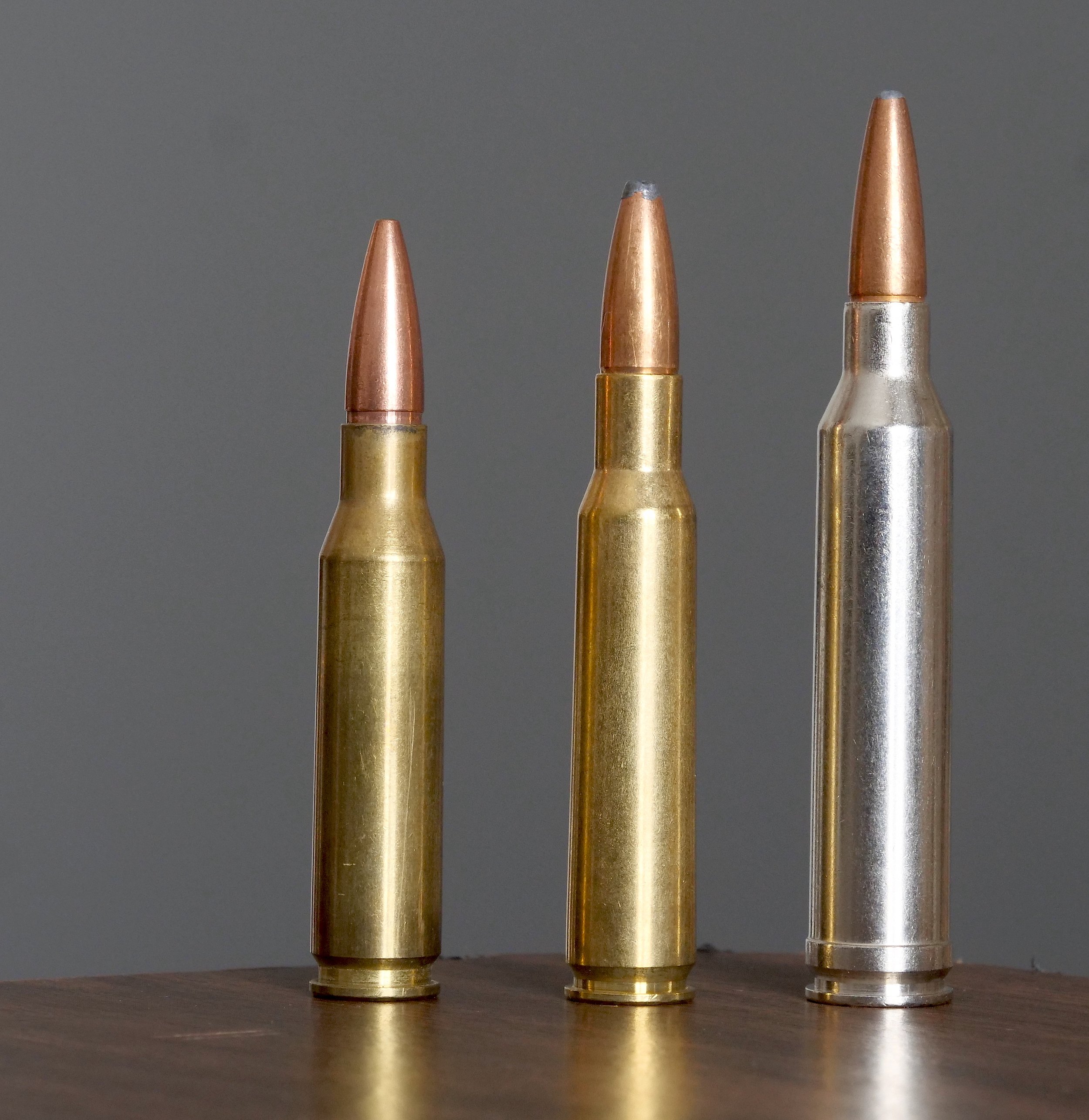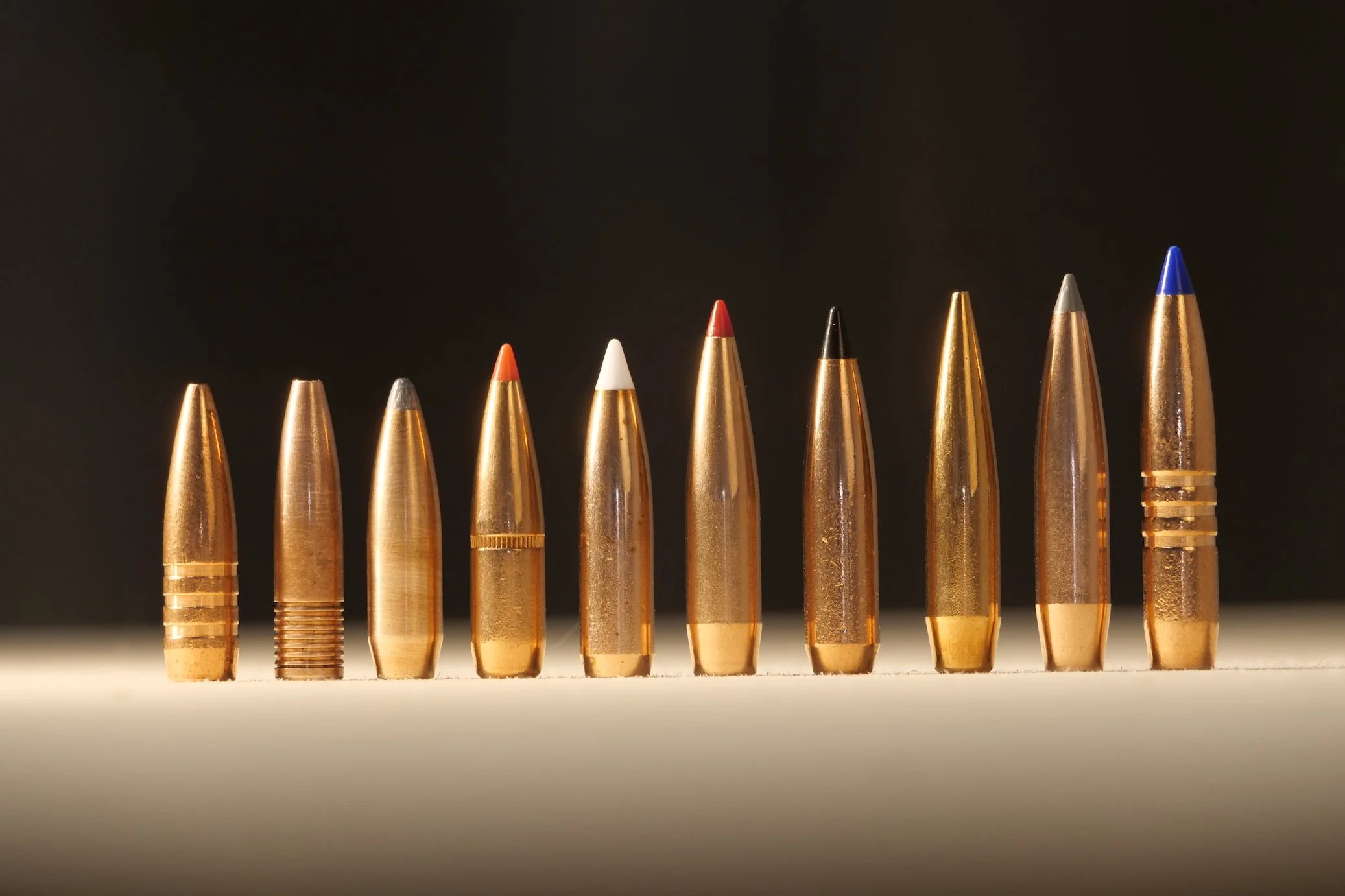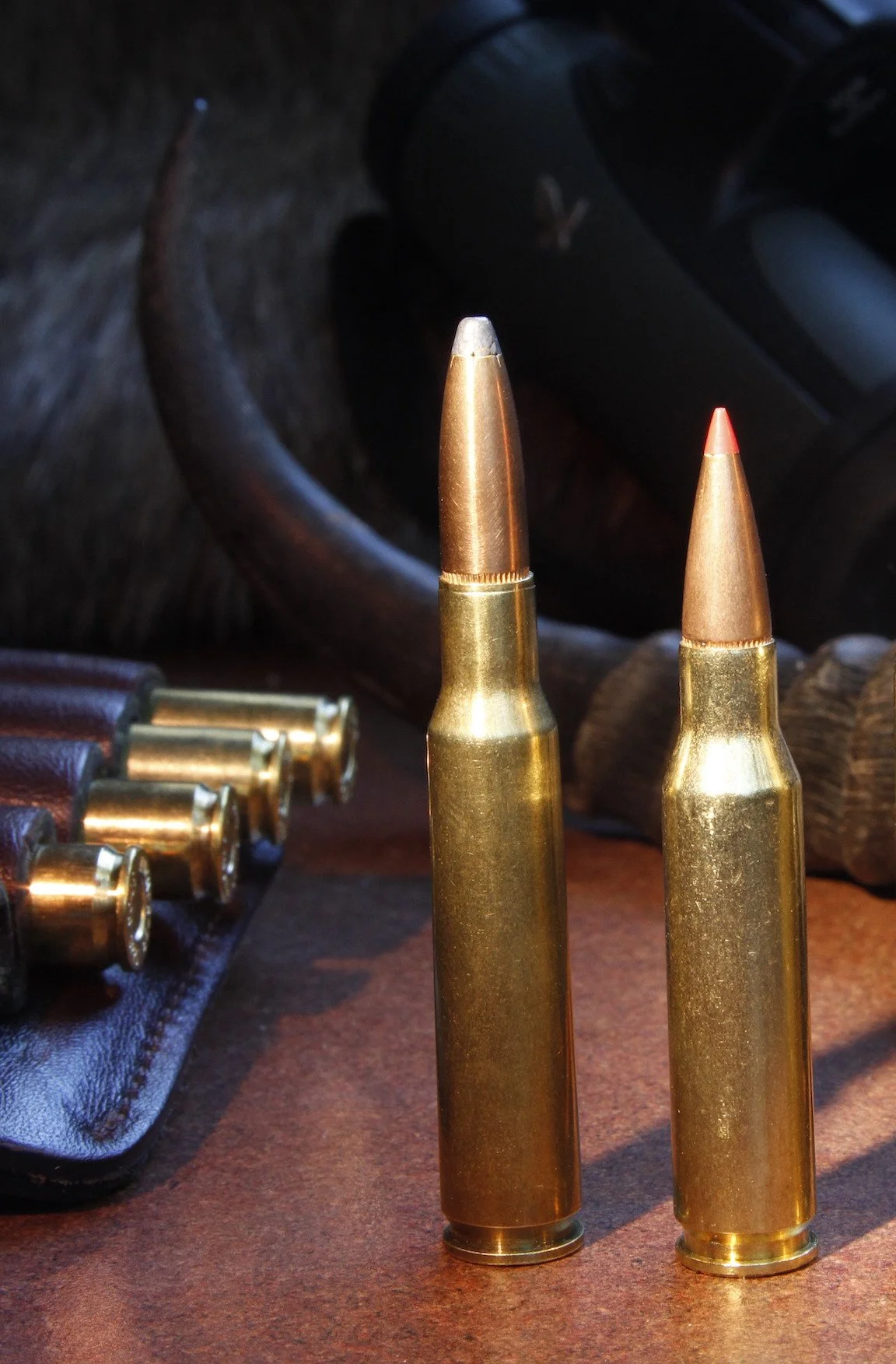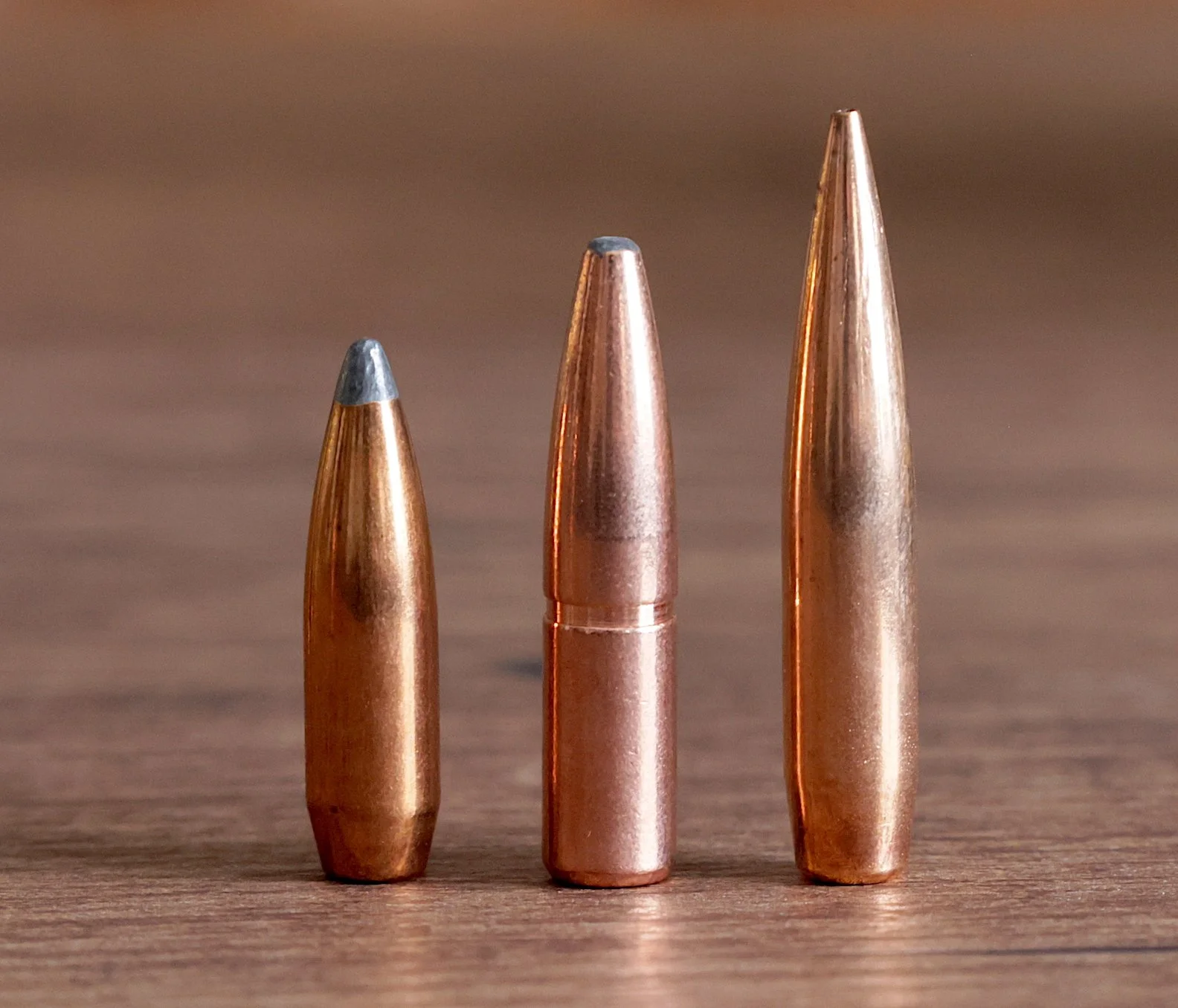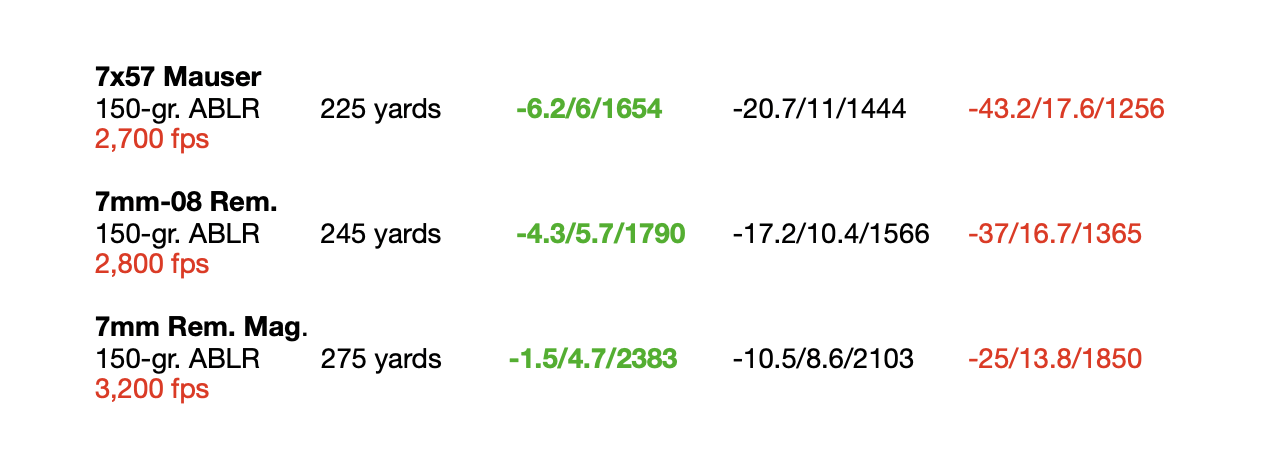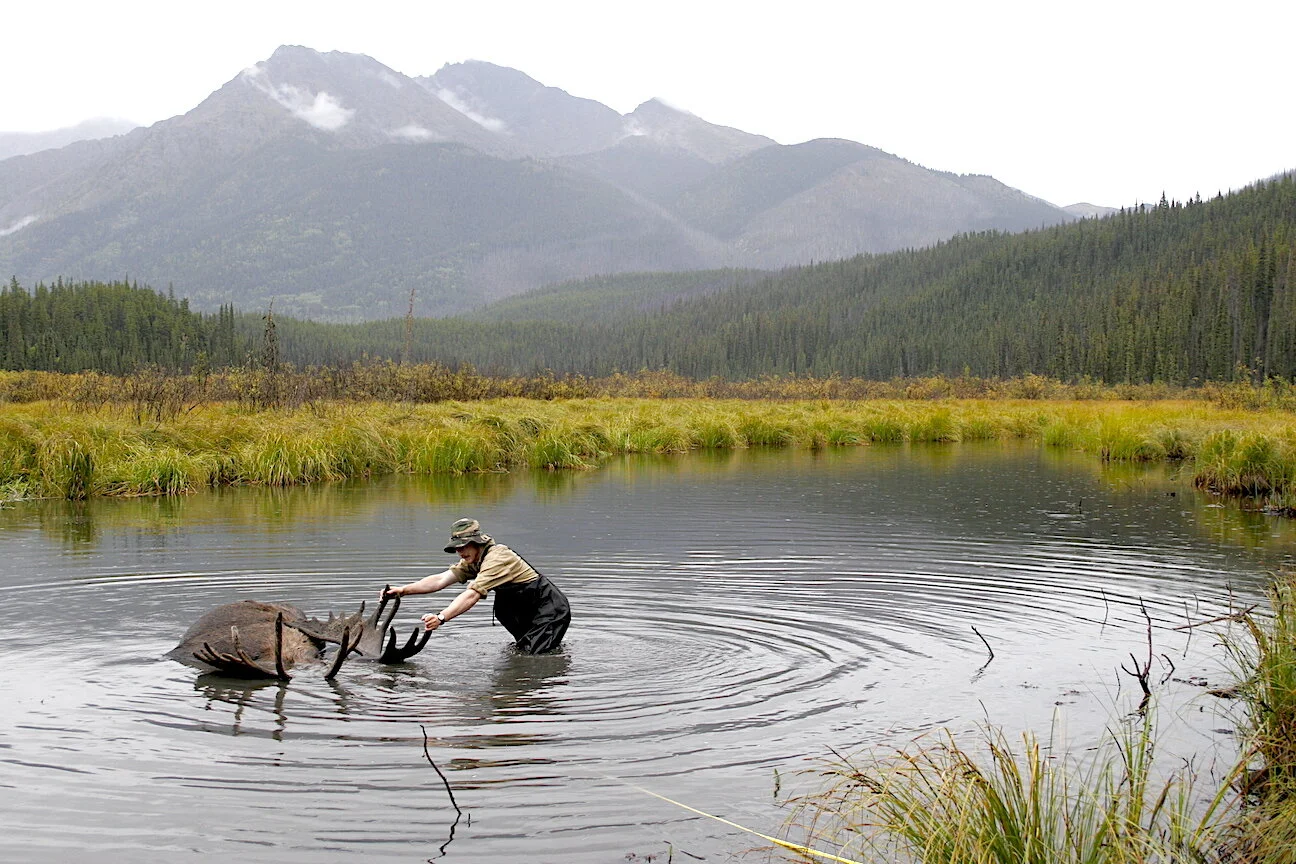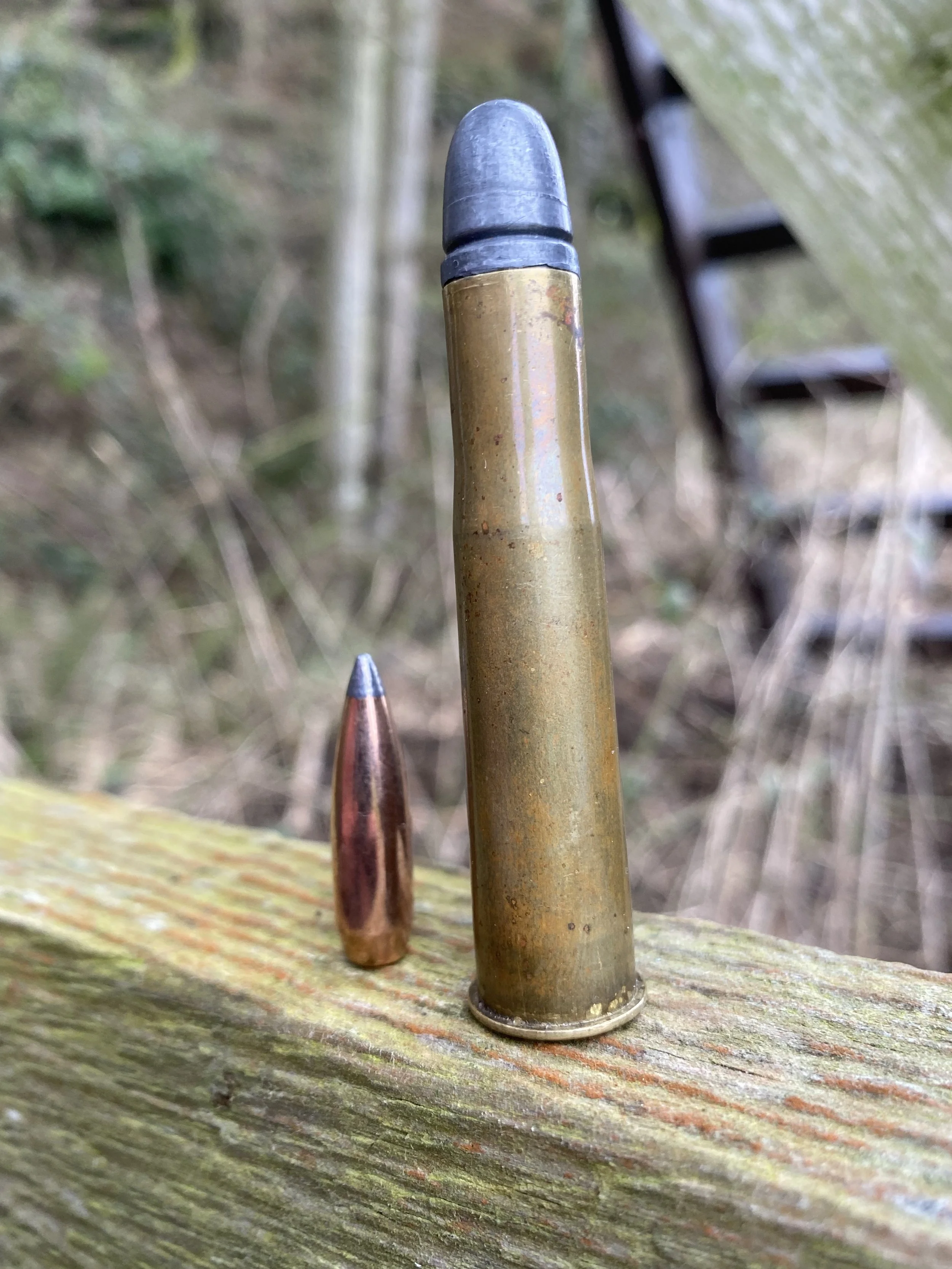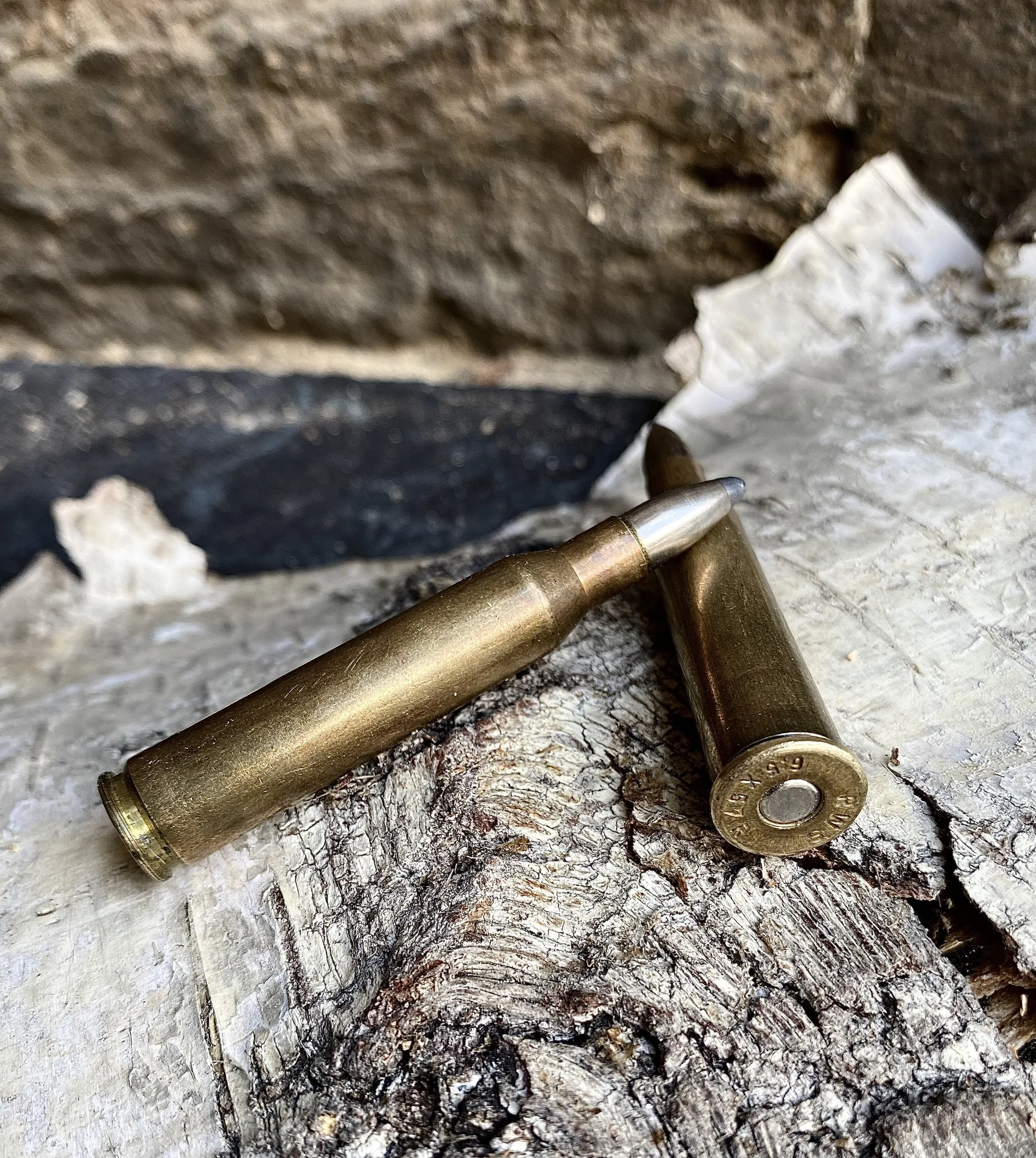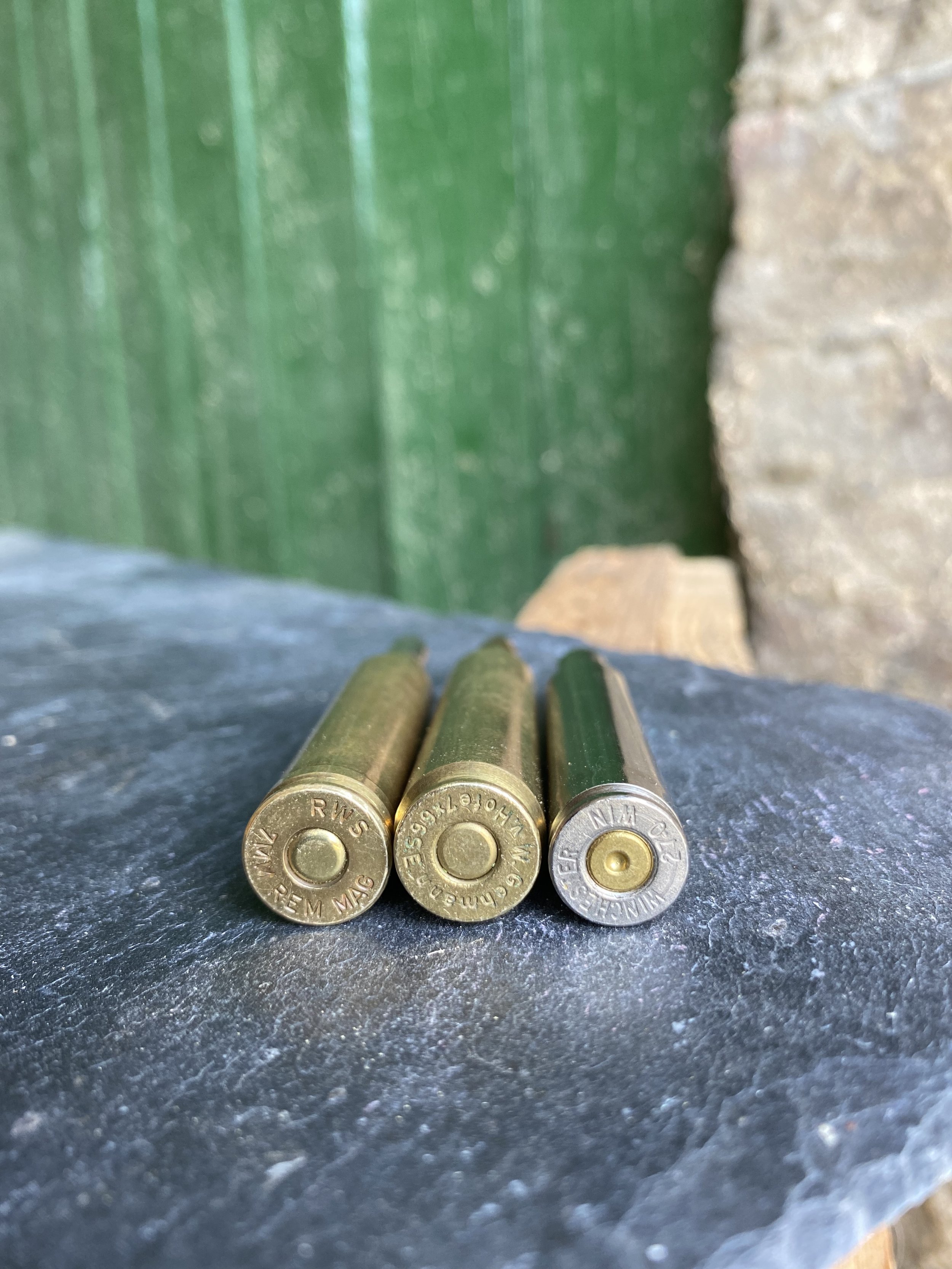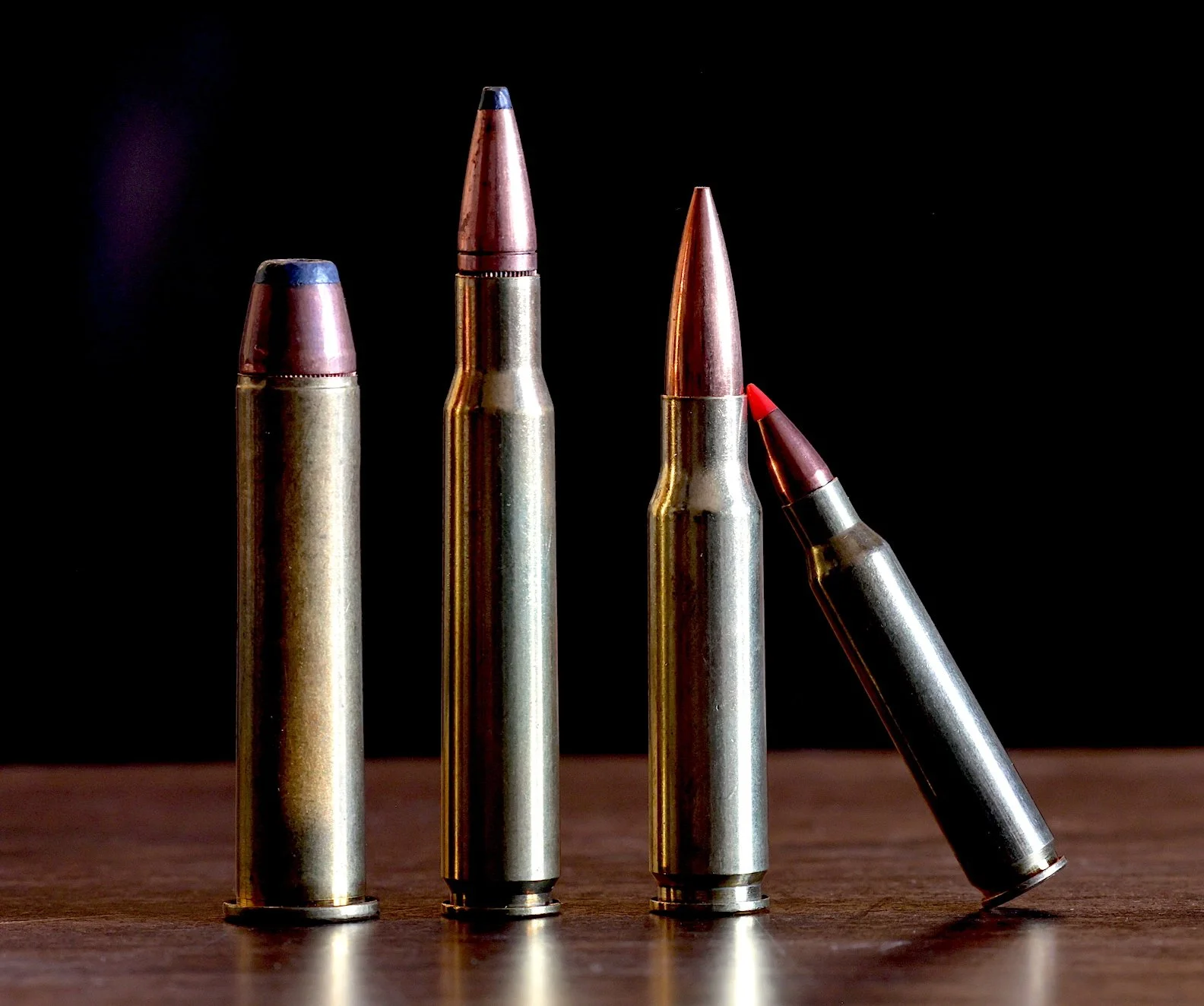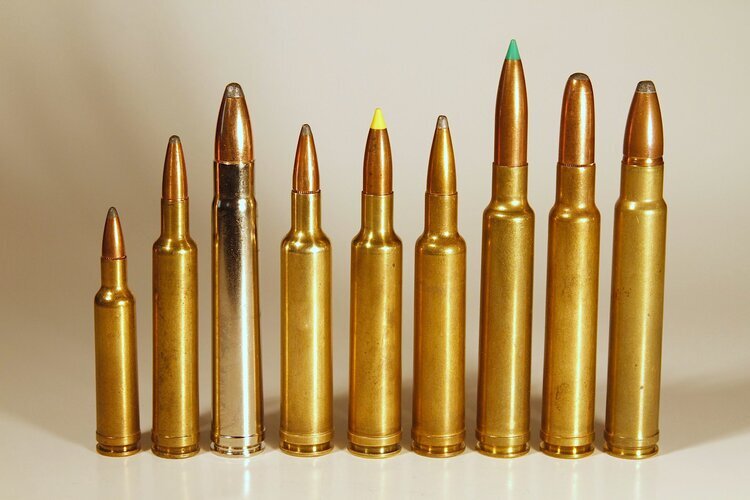7mm-08 Remington vs. 7x57 Mauser & 7mm Remington Magnum
by Ron Spomer
A Patron recently asked two good questions about the 7mm-08 Remington: 1. Is it adequate for elk? and 2. How does it compare to the 7x57mm Mauser?
Fortuitously, another reader asked how close the 7mm-08 Remington comes to 7mm Remington Magnum performance.
Let’s kill three cartridges with one blog right here.
First, allow me to stick my neck out and declare that the under-appreciated 7mm-08 Rem. can terminate anything the 7mm Rem. Mag. can so long as one delivers similar bullets to the same place. Don’t fret over energy levels. Instead concentrate on the bullet and where you park it.
The 7mm-08, 7x57 Mauser, and 7mm Rem. Mag. all shoot the same bullets — and there are a lot of them from 100-grains to 180-grains.
Second, allow me to point out that the 7mm-08 shoots the same bullets as not only the 7mm Rem. Mag., but also the old 7x57mm Mauser. And to put a cherry atop all that, we might recall that famous ivory hunter W.D.M. Bell in the early 20th century used the 275 Rigby, the British designation for the 7x57mm Mauser, to collect 800 elephants while also supplying his extensive camp of helpers and followers with daily meat from kudu, oryx, zebra, hartebeest, wildebeest, warthogs, cape buffalo and all the rest of Uganda’s diverse wild beasts. All shot with the 7mm Mauser. Bell averaged 1.5 bullets per elephant.
With that foundation one would think no other explanation necessary, but we hunters/shooters/ballistic aficionados always hunger for more. More information. More details. More facts and figures on drop, drift, retained velocity and energy and bullet sizes and types and on and on until bedtime. So whip up a cup of hot cocoa and let’s take a dive into the deep end of this 7mm pool. (Discounting for brevity the dozen or so other 7mm cartridges extant. You can read about those here)
History and Performance of the 7x57mm Mauser
When Paul Mauser created his 7x57mm bottlenecked cartridge, the official U.S. military round was still the stodgy, straight-walled 45-70 of 1873.
The 7x57mm Mauser was developed in 1892 as a military cartridge by Peter Paul Mauser of Germany as one of the world’s first rimless, bottlenecked centerfire cartridges for smokeless powder. His famous Model 1892, then 1893, and finally 1898 bolt-action repeaters influenced design of the cartridge and vice versa. The pair worked so reliably that they were adopted by various militaries around the world. The U.S., which met the 7x57 Mauser during the Spanish/American War in Cuba, “borrowed” the cartridge to create the famous 30-06 Springfield which led to the 308 Winchester which spawned the 7mm-08 Remington. Family circus.
From 7x57 Mauser to 30-06 to 308 Winchester to 7mm-08 Remington. It’s a family affair spanning 88 years.
What made and still makes the 7x57 so successful is its moderate length and caliber combined with enough case taper to function smoothly, to feed and extract reliably under poor conditions. Think rain, mud, dust, snow, ice. Bell discovered that German 173-grain round nose full metal jacket military cartridges fed and shot reliably and had more than sufficient power and sectional density to penetrate the skull of the largest African elephant from any angle. On that he bet his fortunes and won them handily, bringing to market enough ivory to retire a wealthy man by his late 30s. (How’s that for a career? Roam and hunt Africa for 16 years and get paid for it? And paid enough to retire to an estate in Scotland? Sign me up.)
Those who would discredit the 7x57 cartridge often do so by pointing out Bell was an exceptional shot. True. He shot flying cormorants with his rifle. But he also killed his big game with a bullet most now consider a wholly inadequate for that purpose — a solid. Full metal jacket. Not exactly optimum wound channel with those. Soft-nose, i.e. expanding bullets, increase the lethality of any projectile applied to any vital spot excepting the brain of some large animals. Bell couldn’t employ any expanding bullet on elephant because they are generally stopped or deflected by thick hair, muscle, and cranial bone. We can argue that the enhanced tissue damaging performance of modern hunting bullets compensates for slightly less precise bullet placement for the average hunter. The 7x57 Mauser can be every bit as effective today as it was for Bell in 1910.
To fully understand how the old Mauser compares to the 7mm-08 Remington and 7mm Rem. Mag., let’s examine ballistic data for the 7x57. We will examine Bell’s original load plus one of today’s factory loads. Note that both have the same muzzle velocity. This is because SAAMI maximum average chamber pressure for the old 7x57 is low at 51,000 psi in case someone fires them through an old, old, potentially weak rifle. With modern, strong rifles many handloaders increase velocity. Even CIP, the European equivalent of SAAMI, allows more chamber pressure in 7x57 factory ammo.
Ballistics of Bell’s 173-gr. Round Nose 275 Rigby (7x57 Mauser) Load
Bell’s 7x57 Load Using Modern, High B.C. Bullet
Enter the 7mm-08 Remington
Now lets jump to the 7mm-08 Remington even though it didn’t become a commercial round until 1980, 18 years after the 7mm Remington Magnum took the country by storm. The big question in 1980 was why backslide? Why go from the hyper velocities of the Rem. Mag. to speeds the 7x57 Mauser had been spitting out for 80 years?
Efficiency is the answer. The 7mm-08’s advantages over the 7mm Rem. Mag. are less cost, blast, and recoil. It’s advantages over the 7x57 Mauser AND Rem. Mag. are it matches or beats Mauser performance and kicks less than the Magnum. It also fits Remington M700 short-action rifles. The 7mm-08 maximum cartridge length is 2.8 inches, just at or under the magazine length of the M700 short-action. The 7x57 Mauser can be 3.065” long. No fit unless you handload and seat bullets deep. Essentially Remington recreated the performance of the venerable 7x57mm Mauser in a necked-down 308 Winchester cartridge that functioned well in their short action rifles. In fact, the Model Seven short-action introduced in 1983 was a perfect fit with the 7mm-08. Short, light, quick, it was considered by many to be the ideal bolt-action whitetail rifle/cartridge combination, sort of a modern version of the lever-action 30-30.
Having hatched from the more modern 308 Winchester case and allowed higher pressures then the 7x57 Mauser, the 7mm-08 of 1980 became a modern version of the old 7mm that would easily fit modern rifle magazines, especially Remington’s M700 short-action and Model Seven.
Of course there’s no ballistic contest when you pit either of these shorter 7mms against the 7mm Remington Magnum, a standard-length cartridge on a fatter, belted case fitting the same-length magazines as the 30-06. We’ll detail that a bit deeper into this report. With most bullets seated to standard cartridge overall length, the 7x57 capacity is about 3 grains more than the 7mm-08’s.
Another significant advantage the -08 has over the Mauser is 61,000 psi max. average chamber pressure. This gives it more velocity out of less powder space. According to Nosler Reloading Guide 9, 45 grains of IMR 4831 behind a 175-grain Accubond Long Range yields 2,612 fps MV. Dribble 2-grains more into the 7x57 Mauser and get just 2,498 fps. Ah, but look more closely! The 7mm-08 was measured from a 26-inch barrel, the 7x57 a 22-inch. Subtract 25 fps per inch and the 7mm-08 is down to a closer 2,512 fps. That’s roughly the typical muzzle velocity difference between these two: a 100 fps advantage for the 7mm-08.
The longer 7x57mm Mauser holds roughly 3 grains more powder than the 7mm-08 Remington, but higher chamber pressures allowed in the 7-08 account for its 100 fps average M.V. advantage.
To be fair, the Speer Manual #15 compares both in 24-inch barrels and arrives at essentially the same MV with 175-grain bullets, but using different powders for each. When they list top loads for both with Reloader 19 powder, the 7mm-08 gets 2,628 fps with 47 grains powder, the 7x57 hits 2,529 fps with 48 grains. HOWEVER, the Speer manual warns users: “DO NOT EXCEED STARTING LOADS LISTED IN THIS MANUAL” if shooting the ammo in Spanish Model 1893 or 1895 Mauser actions. Those starting loads equal the velocities of American-made 7x57 Mauser ammo. So in factory loads the 7mm-08 Rem. does have a velocity advantage. At the same time, however, it’s nearly impossible to find a 7mm-08 factory load carrying a bullet heavier than 150-grains. I’ve found 7x57 Mauser ammo fitted with 156-, 158-, 162-, 173- and 175 grain bullets. Factory 7mm-08s seem to come with 120-, 139-, 140-, and 150-grain bullets only. But something new could pop at any time.
Here, then, are some 7mm-08 Remington ballistics with the same 175-grain bullet we used in the Mauser. The Hornady reloading guide, 10th edition, shows a top load of 45.9 grains H414 reaching 2,600 fps MV from a 24-inch barrel, a crazy, 300 fps advantage over the Mauser. But, once again, the Mauser loads were measured out of a 22-inch barrel, so, figuring an average 25 fps per inch of barrel velocity change, we’ll drop our 7mm-08 load to 2,550 fps. Here are the results:
7mm-08, 175-gr. Hornady ELD-X Trajectory Table
Better, Lighter Options For Deer
Because the 7mm-08 is considered by many the ideal, low-recoil 7mm whitetail round, let’s compare its ballistics to the 7x57’s using the popular 140-grain “deer” bullet. I have chosen Federal’s factory ammo velocities because they load both these 7s with 140-grain Partition bullets.
7x57 Mauser, 140-grain Nosler Partition Trajectory Table
7mm-08 Remington, 140-grain Nosler Partition Trajectory Table
Note that I zeroed each for a peak mid-range trajectory around 3 inches. This extends their maximum point blank range. Notice that at 300 yards the faster 7mm-08 has just a 1.5-inch drop advantage, 1/2-inch wind deflection advantage, and about 160-f-p energy advantage. I doubt most shooters or shootees would notice. The 500-yard differences are starting to add up, suggesting enough 7mm-08 advantage, especially in drop, that factory ammo shooters might prefer that one.
Enter The Dragon — 7mm Remington Magnum
The 7mm Remington Magnum towers over its 7mm-08 little cousin.
But what about that magnum? If we have one of THE most popular 7mms of all time, why even bother with these small 7s? Let’s consider what the 7mm Rem. Mag. can do with Hornady’s 175-grain ELD-X bullet. Hornady’s manual suggest a top end MV of 2,900 fps. Nosler’s indicates 2,970 fps. Let’s compromise at 2,950 fps from a 24-inch barrel.
7mm Remington Magnum, 175-grain Hornady ELD-X Trajectory Table
Compare the 500-yard trajectory of this against the other two and you appreciate its huge advantage. Sixteen to 30 inches less drop. Three to six inches less wind deflection. We’re talking hit versus miss — unless you employ your laser rangefinder, estimate the wind speed accurately, know your drops and drifts, and compensate accordingly. Then the only difference is remaining energy. The following abbreviated chart conveniently illustrates differences.
Look at those 500-yard energies. Whoa. That 7mm Remington Magnum is a powerhouse. But…how much difference does 600 f-p energy make to a deer, elk, moose, or even a 2,000-pound eland or 1,200-pound brown bear?
Who knows? Some say a lot. Others say almost none so long as that bullet penetrates the right place. Ah, bullet penetration. Interesting concept, that. Let’s investigate it.
Bullet width, mass, impact velocity, and expansion all contribute toward penetration. The narrower the bullet for its mass, the deeper it should penetrate. The more it expands, the shallower it penetrates. Think FMJ solid versus soft point. And think 120-grain .284” versus 175-grain .284”. With equal nose expansion, the 175 will penetrate farther due to something we call Sectional Density. All else being equal (materials, construction, velocity,) the 175, because it has more mass in the shank, retains more momentum. The heavy rear keeps pushing the nose forward, mushroomed or not.
The longer the bullet in any caliber, the higher its Sectional Density. But that isn’t the only determinant for penetration. Bullet construction plays a huge role. The 175-grain Swift A-Frame in center will penetrate farther than the 130-grain Sierra soft-point at left and Berger E.O.L. 195-grain because the A-Frame has thicker walls of pure copper, an interior wall isolating and locking in the rear shank lead, and a bonded lead nose core.
The confusing thing about Sectional Density is there’s no standard measure of penetration performance. The best anyone can do is predict that the longer a bullet for its caliber and mass, the deeper it should go. And the more energy it will carry at all distances. So yes, by all means, if you wish to maximize penetration and on-target energy, shoot the Rem. Mag. But don’t imagine the 7x57 Mauser and 7mm-08 bullets are going to bounce off.
Look again at those energy numbers. If you subscribe to the theory that you need 1,500 f-p impact energy for a good elk bullet, the 7x57 keeps it to 275 yards. The 7mm-08 Rem. takes it to 475 yards. If you insists on 1,000 f-p for deer, sheep, mountain goat and similar sized game, both these smaller 7s will take you beyond 500 yards. Now be honest with yourself. How many shots are you going to take beyond 500 yards? And even if you do, is a 175-grain bullet packing 1,169 f-p going to cause a mere scratch? A 170-grain bullet from the beloved and celebrated 30-30 Winchester carries just 920 f-p energy at 200 yards, and there aren’t many who think it insufficient.
Case Histories
While “Karamojo” Bell is exhibit A for the 275 Rigby/7x57mm Mauser, thousands of other hunters from Jim Corbett (tigers,) Eleanor O’Connor (and husband Jack,) Craig Boddington, John Barsness, and perhaps you and me have confirmed the 7x57’s bona fides. I suspect the reason it never became as popular in the USA as in Europe was its initial use against us. Once we modified it to create the 30-06 to fight two wars against the nation in which it was spawned, fidelity to the 30-caliber was inevitable. Nevertheless, international hunters proved again and again the 7x57mm Mauser could anchor anything. With today’s superior bullets and powders, it’s better than ever.
The Dakota falling block Model 10 single-shot chambered 7x57 Mauser pushing 150-grain Barnes TTSX bullets proved more than powerful enough for the splendid example of a bull roan, the second largest antelope species in Africa.
During a hunt with Fort Richmond Safaris near Kimberly I discovered a single-shot Dakota M10 in 7x57 pushing 150-grain Barnes TTSX bullets easy shooting and absolutely deadly on warthog, blesbuck, kudu, and roan, killing faster and more decisively than a 300-grain TSX from a 45-70.
I had no 7mm-08 at Fort Richmond for immediate comparison, but over the years this little 7mm has proven equally deadly on kudu, wildebeest, caribou, mountain goats, and various deer. And why wouldn’t it? It’s in essence the 7x57 in a slightly modified container.
A couple of 140-grain Swift A-Frames launched by this unusual, sub-5-pound Kifaru Rambling Rifle in 7mm-08 Remington dropped this massive bull mountain caribou in the wilds of British Columbia. Guide/outfitter Brian Martin.
Then there’s the 7mm Remington Magnum. Whatever the Mauser can do, it can do. Same bullets. Just faster and carrying more energy. Complaints of slow killing, insufficient “knockdown power,” and bullets “moving too fast to open” are likely reflections of poor bullet selection or placement. More than a few new owners of the overly hyped “hyper-velocity” 7mm Rem. Mag. have demonstrated recoil anticipation with a hardy flinch. Yet this mighty seven isn’t really uncomfortable to shoot. In an eight-pound rifle throwing a 175-grain bullet 2,950 fps it will generate 31 f-p recoil energy at 15.8 fps recoil velocity. Compare this to a 300 Win. Mag., 180-grain at 3,050 fps, which kicks up 32.8 f-p. Those who claim the 7mm has a sharper recoil might be surprised to learn that the recoil velocity of this 300 Win. Mag. load is 16.2 fps, slightly faster than the 7mm Rem. Mag.
The thing about recoil is you know it when you feel it. And if you feel a 7mm Rem. Mag. is more than you enjoy, the Mauser and 7mm-08 are there for you. Expect about 18.4 f-p recoil at 12.2 fps velocity. Easy. And if even that is too much, step down to a 140-grain bullet at 2,800 fps for a mild 15.6 f-p at 11.2 fps.
This lovely eland bull probably weighed 1,800 pounds. A pair of 140-grain Barnes TTSX bullets from a Blaser R8 in 7mm Remington Magnum handled it nicely. Zeiss binocular and scope made finding and targeting bright and easy.
Mid-Weight Bullets
The right 140- to 150-grain bullet in any of these 7mms can be remarkably effective. So effective that you may never need to anticipate the recoil of a 175-grain. As most of us have learned over many hunting seasons, a premium, controlled expansion bullet matched to anticipated impact velocity delivers optimum terminal performance. Since the early 1980s I’ve learned first hand that a .284-inch, 140-grain Nosler Partition at 2,800 fps can anchor a 6x6 elk with one touch. A 150-grain Barnes X can do the same, even from 450 yards out. A 140-grain Swift A-Frame applied to the shoulder of a massive mountain caribou means game over. A couple of Barnes TTSX finished a southern eland bull that weighed 1,800 pounds if he weighed an ounce. Bull moose? No match for a 150-grain Barnes. Kudu, oryx, blue wildebeest… All have regretted the day they met a 140- to 150-grain .284 bullet thrown 2,800 fps or faster.
I report this to suggest that, much as we like the added punch and penetration potential of a 175-grain .284 bullet, we probably, likely, don’t need it. It’s there if you want it, but my experience suggests a good premium 140- to 150-grain will suffice. And that means less recoil, and flatter trajectories. Compare the trajectories and energies in this next chart to appreciate the performance of mid-weight 7mm bullets.
120-grains to Lighten the Load
For some odd reason you rarely hear of, let alone see, bullets lighter than about 140-grains on any of these 7mm cartridges, yet 120-grain bullets yield flatter trajectories and more than sufficient energies for slightly smaller animals such as pronghorns, Coues whitetails, coyotes, javelina, impala, and blesbuck. A well designed 120-grain may not resist wind deflection as well as a 175-grain, but it will shoot flatter and recoil less. Combine that with the weight retention and penetration of an all copper expanding bullet and you’re golden.
Conclusion
The obvious conclusion for me is the 7mm Remington Magnum is the most versatile option if you don’t mind the recoil or a standard-length action. The 7mm-08 Remington is the best option in a “true” short-action rifle with less recoil unless you want to shoot factory ammunition with bullets heavier than 150-grain. Then the 7x57 Mauser is your baby. But in a standard-length action. You’ll find the most factory ammo options in the 7mm Rem. Mag. You’ll get maximum potential out of both the 7mm-08 Remington and 7x57 Mauser if you handload. In fact, given the reduction in pressures, thus velocities, of most factory 7mm Remington Magnum ammo these days, you’ll improve that one by handloading, too.
As for field performance, so long as you can deliver the right bullet to the right place, game isn’t going to know what you’re shooting. If Bell could collect 800 elephants with an average of 1.5 shots for each using the weakest of these three outstanding 7mms, you and I ought to be sufficiently prepared for elk and whitetails.
Conclusion:


